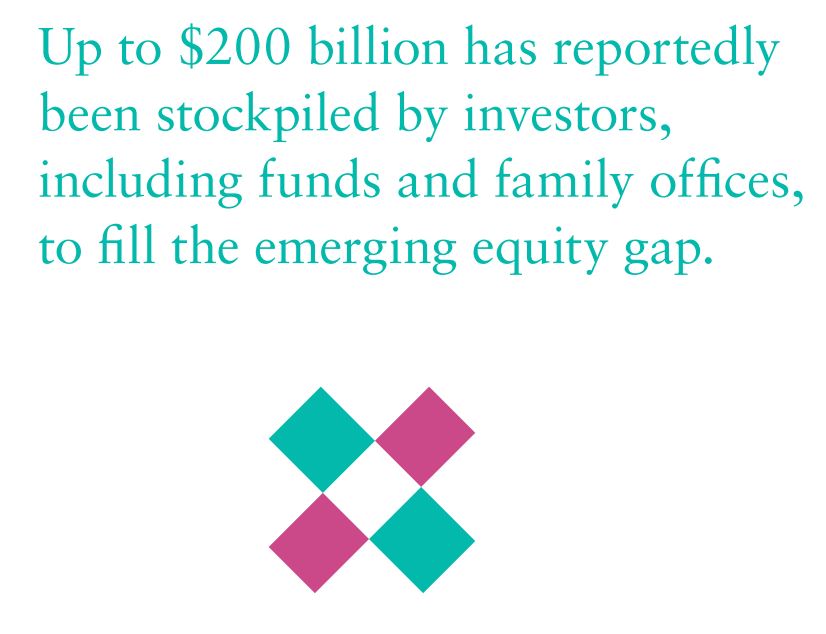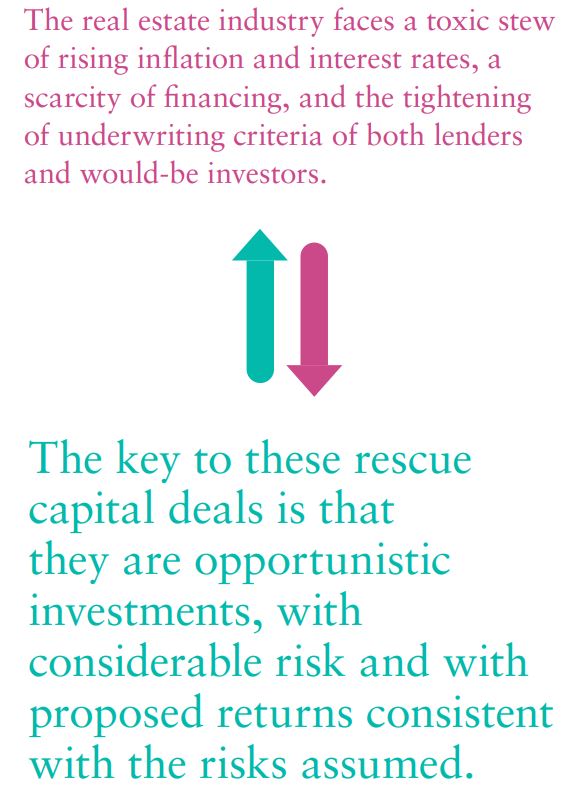Hard times make for opportunistic strategies and rescue capital could see increased adoption in the current climate. How should investors prepare?
In the past seventeen months, the climate for real estate ownership and investment has shifted dramatically for the worse, ending a remarkably favorable investment climate since the Great Financial Crisis.
The real estate industry faces a toxic stew of rising inflation and interest rates, a scarcity of financing, and the tightening of underwriting criteria of both lenders and would-be investors. More troubling, the future of the office, retail, hospitality, and residential sectors is no longer easily predictable, and the trendlines now skew to the negative, given a potential cyclical downturn combined with longer term secular changes due to remote work, internet sales, changing travel patterns, and an increasing treatment of housing as a public utility.
THE CURRENT STAGE
Many properties are already “below water” on a current and prospective basis, giving rise to a wave of distressed debt transactions and properties being surrendered to lenders, even by established real estate players. However, many other properties, while still generating positive net cash flow (even taking current debt service into account), face a large gap in their capital structure and a projected drop in occupancy and rental income that, if not addressed, may or will result in catastrophe.
But why?
First, the cash flow of these “zombie” properties is fragile. The demand (and price) for office space in new leases projects to be materially less than for leases entered into pre-2022. The long-term prognosis for retail is unclear. Hospitality trends are at best opaque. Housing is being impacted by governmental initiatives to reduce or cap rents or deter evictions.
Contemporaneously, terms of available financing are unlikely in many cases to generate sufficient principal to refinance existing debt. This is particularly the case for development properties or properties under construction, properties with impending vacancies, and properties refinanced at the valuations characteristic of the years immediately preceding 2022.

Third, there are few flight capital or “Prince Charming” investors ready to purchase properties at prices that will solve these problems.
Fourth, many properties need substantial capital infusions for lease-up, repositioning, upgrades, or environmental retrofitting. Ground-leased properties may face substantial rent resets, and “B” and “C” properties are especially vulnerable.
Fifth, some ownership groups are unable to provide additional capital, even where the return might justify the investment (for example, fund owners facing redemption calls or trigger dates for liquidation).
On the other hand, up to $200 billion has reportedly been stockpiled by investors, including funds and family offices, to fill the emerging equity gap. This so-called “rescue capital” is not necessarily focused on property purchases, but may elect to negotiate an acquisition of a substantial (and usually preeminent) equity interest in existing property owners, sometimes with full control rights, sometimes not.
PLACING RESCUE CAPITAL
The key to these rescue capital deals is that they are opportunistic investments, with considerable risk and with proposed returns consistent with the risks assumed. The days of core, core-plus, or even value-add capital seem somewhat remote.
We are seeing a return to deal structures and approaches similar to those in the early Reagan presidency, with equity squeeze-downs, “debt-flavored” equity, “equity-flavored” debt, split debt-equity investments, conversion rights, and the like. Moreover, these are not “win-win” transactions. Existing capital will be impaired, perhaps severely. Many of these transactions will provide existing ownership with the equity equivalent of a “hope note,” so that they are effectively subordinated to a return on and perhaps of any new money invested.
Why would existing ownership cooperate? One reason is that the alternative may be a total loss or years of litigation with lenders. Reputational risk may be at stake. There may be tax benefits to a rescue capital solution. The new investor may be willing to allow management rights and fee income to remain with existing management. And, at bottom, a “hope note” may be preferred to wipe-out.
NEGOTIATIONS AND CONSIDERATIONS
Rescue capital transactions are complex. Joint venture agreements are complicated to negotiate ab initio and even more difficult to restructure, where there are clear winners and serious losers and less security of outcome.
- Given the sensitivity of rescue capital negotiations, both nondisclosure agreements and agreements negating oral agreements should be considered before discussions are commenced.
- Underwriting is more complicated. The new investor must not only perform due diligence on a property, but on the historic operation of the entity’s business and the peculiar liabilities and tax attributes of the entity, most of which would not be relevant in a property sale. The existing ownership must be vetted on a know-your-client basis. The new investor is concerned with undisclosed (e.g., tax) matters that are not easily diligenced.
- Representations and warranties are more extensive and contentious, covering matters not usually mentioned in a property purchase. Someone is generally left liable for these expanded representations and warranties that, due to their nature, usually have a longer survival period and greater potential damages. Indemnities, security, and reserves are often required, which some existing owners cannot provide, and which others will not provide. Representation and warranty insurance, or tax insurance, can often fill this gap, although many real estate professionals are not experienced with these products. In corporate transactions this insurance has become widely used.
- In the current environment, projections of future net revenues, capital expenditures, and financing, and requirements for future capital inputs, may be somewhat speculative. Yet the new waterfall and the commitment of the new investor are harder to negotiate without some consensus on these items.
- If the new investor proposes to invest without a refi nancing of the existing indebtedness, then each existing lenders is a party to the negotiation. Some lenders are more willing to negotiate than others. CMBS lenders will operate through special servicers, which generally creates a substantial fee burden whether or not the negotiation is successful. Mezzanine lenders who are “out-of-the-money” may be understandably cranky. However, there is market evidence that, in the current environment, some institutional lenders see it advantageous to cooperate with rescue capital sources to create a stable borrower and less distressed loan.
- The rescue capital transaction may, without lender consent, constitute a default under existing loan documents by violating “due-on-sale,” “due on encumbrance,” “no change in control” or other covenants. Even more seriously, the transaction terms may create guarantor liability under so-called “non-recourse carve-out” guaranties. Lender waiver of the provisions is generally required. In one instance, a would-be rescuer was sued for tortious interference with contractual relations by nonconsenting lenders.
- Responsibility for guaranties will be a negotiating issue. Does the “new money” need to join in or execute a new guaranty or a replacement or supplemental guaranty? The guarantor(s) will want a guaranty fee, or an indemnity from non-guarantors.
- Management and rights must be negotiated. Does existing management continue or is it replaced? What about manager-affiliates? Can management (whether the existing group or the “new money” group) be replaced? Does existing management get removed if it fails to meet agreed projections? Who controls day-to-day operations and who participates in major decisions? How are deadlocks broken? Buy-sells and forced sales are frequent strategies adopted in newly formed joint ventures, but may not be palatable in rescue capital situations.
- The new waterfall for distributions is a crucial negotiation. To some extent, it depends on the amount, timing and application of new money. Since many joint ventures have complicated waterfalls, with preferred returns, IRR based floors, promotes, fees and the like; rejiggering them in the cathected and uncertain environment of a work-out is not a simple task.
- The rights of new money to determine the investment period will be negotiated. Some investors (and sometimes existing sponsors or investors) will require the right to terminate the investment after a prescribed period. Similarly, control over the nature and timing of future recapitalization or refinancing may be a discussion point.
- Transfer rights are particularly important. The parties may discuss puts, calls, drag-along rights, tag-along rights, ROFOs, ROFRs and the like. Conversely, restrictions on the rights of transfer of direct or indirect interests will have to be negotiated.
NEW MONEY

The attributes of the new money are a principal discussion point. Existing lenders may have prohibited debt financing, and a violation of this prohibition may bring on liability to guarantors. However, some new money sources (particularly foreign investors) may prefer to invest so as to obtain characterization as “debt” for tax or accounting purposes, or may just want equity rights so “debt-like” that it possible for the “equity” to be recharacterized as “debt.”
For example, some preferred equity investors will want fixed payment dates and maturity dates for their returns on and of capital contributions and debtlike remedies, the right to replace management, or so-called “equity kickers”. Some money sources will insist on treatment as equity, particularly to benefit from the tax provisions (i.e., depreciation) that follow.
There may be a complex tax discussion, as the rescue capital investor may propose to maximize its tax position, which may disadvantage certain existing investors. Negotiations will focus on who has the ability to make certain elections and decisions regarding where tax attributes are allocated (for example, depreciation, tax credits, and “phantom income”) and whether distributions will be made to cover taxable income or gain generated by the transaction. New investors may want to design an exit strategy as a tax-free redemption, but that may impose adverse tax consequence on the original investors.
In some jurisdictions, rescue capital transactions will be subject to transfer taxes (particularly where 50% of more of the equity is transferred), or a reassessment of the property for property tax purposes (as with California’s Prop 13). New York State is proposing a tax on preferred equity.
Bankruptcy and insolvency risks and opportunities must also be taken into account. One particularly sensitive issue is determining who can and cannot make a bankruptcy election, and whether this provision is enforceable. In some cases, a “friendly” bankruptcy sale may be precipitated for the principal purpose of avoiding transfer tax.
RETHINKING STRATEGY
Hard times make for hard choices and opportunistic strategies. The rescue capital approach will be increasingly adopted in the current challenging environment for real estate ownership and investment.
It requires significant expertise and complex analysis to achieve a satisfactory conclusion for any of the parties. And experienced advisors are very helpful, particularly where deal structures reemerge that were unfamiliar in the past few sunny decades.
EXLORE THE FULL ISSUE

ALSO IN THIS ISSUE
AFIRE INTERNATIONAL INVESTOR SURVEY: Q1 2023 PULSE REPORT
Gunnar Branson and Benjamin van Loon | AFIRE
VALUATION CHALLENGE: SOLVING THE CRISIS IN COMMERCIAL REAL ESTATE VALUATION
Matt Pomeroy, MAI and Jackie Bowie | Chatham Financial
CONVERSION CALCULATOR: LEGAL OR NOT, A DYNAMIC CITY WILL CONVERT UNUSED OFFICES
Jim Costello | MSCI Real Assets
UNDERWRITING ROADBLOCKS: CAN THE HOSPITALITY MODEL OF UNDERWRITING SAVE OFFICE VALUES?
Joshua Harris, PhD | Lakemont Group & Fordham University
VACANT SPACE: OFFICE-USING JOBS AND DEMAND INCONGRUITY
Stewart Rubin and Dakota Firenze | New York Life Real Estate Investors
HIKING TRAILS: SHOULD INVESTORS CONSIDER ALLOCATIONS TO FLOATING-RATE DEBT?
Dags Chen, CFA | Barings Real Estate
RECESSION PREPPING: HOW VULNERABLE ARE COMMERCIAL MORTGAGE INVESTMENTS
Martha Peyton, PhD | Aegon Asset Management
MEASURING GENTRIFICATION: USING DATA SCIENCE TO PREDICT THE IMPACTS OF GENTRIFICATION
Ron Bekkerman | Cherre + Donal Warde | Tenney 110 + Maxime C. Cohen | McGill University
THE FUTURE IS EUROPEAN: THEMES FROM THE OLD WORLD SHAPING US MARKETS
Brian Klinksiek | LaSalle Investment Management
CULTURE SHOCK: THE CHALLENGE AND IMPORTANCE OF TRANSLATING ESG ACROSS BORDERS
AFIRE ESG Committee
FINE TUNING: GLOBAL REACH AND LOCAL EXPERTISE CAN CREATE UNIFIED REAL ESTATE EXPERIENCES
Mark Zettl | JLL
ACCESSING SUCCES: EXPLORING DIVERSITY TRENDS IN REAL ESTATE TALENT
Zoe Huges | NAREIM
RESCUE CAPITAL: RESPONDING TO THE NEW REAL ESTATE REALITY
Andrew Weiner and Joshua M. R. Becker | Pillsbury
CONVEX CURVES: A REMINDER ON PRICE CONVEXIVITY AND CAP-RATE VOLATILITY
Joseph Pagliari, PhD, CFA, CPA | University of Chicago
IN MEMORIAM: ANDREA MARIE CHEGUT, PhD, MIT

—
ABOUT THE AUTHORS
Andrew Weiner is a Partner in the Real Estate Group and Josh Becker is a Counsel in the Tax Group for Pillsbury Winthrop Shaw Pittman LLP, a full-service, global law firm with an industry focus on investment activities in all asset classes, energy and natural resources, and financial services. Both are based in New York City.
—

